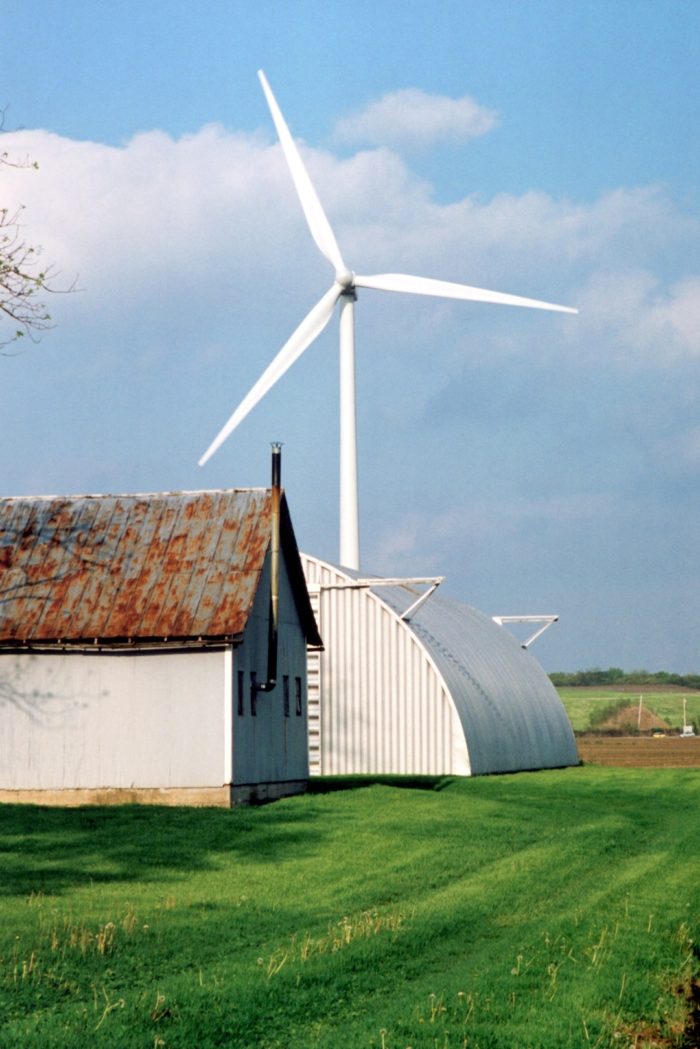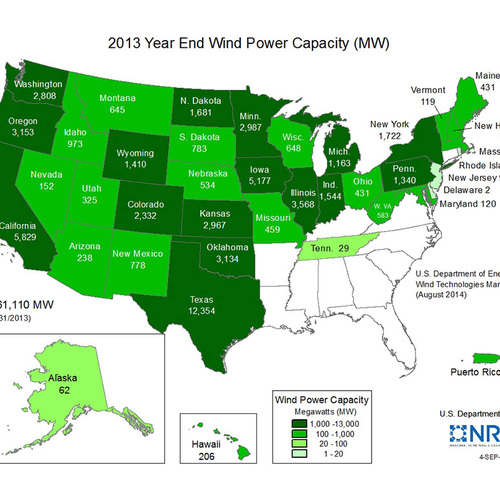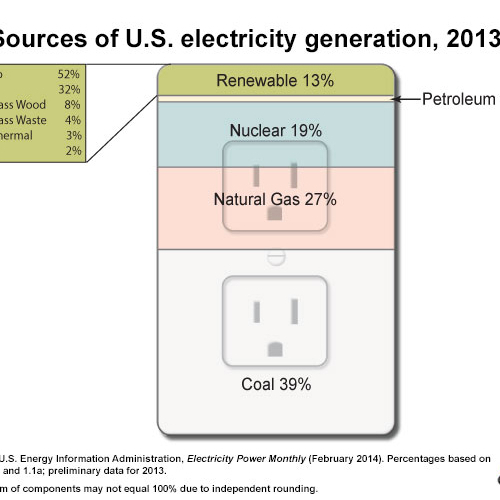
Image Credit: Ohio Office of Energy Efficiency
Just a few weeks after rolling back renewable energy standards, Ohio lawmakers have approved a bill increasing required setbacks for wind turbines.
New commercial wind farms will now have to meet a setback of 1,125 feet from the tip of a turbine’s blades to the nearest property line, Midwest Energy News reported. Previously, the Ohio Power siting Board had measured the setback to the outer wall of the nearest occupied house. Otherwise, the property line setbacks were about 550 feet, the report said.
The change isn’t sitting well with wind farm developers.
Eric Thumma, director of policy and regulatory affairs for Iberdrola Renewables, the U.S. arm of the Spanish energy conglomerate, said the law would probably scuttle two projects that have not yet received permits. One of them, he said, would see a drop in the number of turbines from 50 to seven; and the other from 75 to three.
Iberdrola has roughly 10 projects under permit but not yet constructed. Those will be allowed to proceed, providing no permit amendments are required, Midwest Energy News said.
In effect, Thumma said, the legislation “basically zones new wind projects out of Ohio.”
Little public debate
Dayna Baird Payne, a lobbyist representing both the American Wind Energy Association and Iberdrola, said, legislators didn’t discuss the new setback requirements with either the wind industry or the Ohio Power Siting Board.
The Ohio Senate, the report adds, spent about 10 minutes discussing the changes before approving the bill at the end of May.
State Senator Mike Skindell pointed out that oil or gas wells needed only a 100- or 200-foot setback from nearby houses. “I’m dumfounded,” he said.
But State Sen. Bill Seitz said turbines are noisy, and that Ohio was still “very friendly” to wind farms despite the tighter rules.
In a press release, Wind Energy Association CEO Tom Kiernan said the governor had “walked away from his commitment to renewable energy,” and had succeeded in creating an unfriendly business environment in the state. He said the move would force clean energy developers to move to neighboring states.
According to the Wind Energy Association, Ohio currently has 432 MW of installed wind capacity, ranking it 26th in the country. There are 32 wind projects online with a total of 246 turbines. Less than 1% of the state’s electricity is generated by wind.
Weekly Newsletter
Get building science and energy efficiency advice, plus special offers, in your inbox.















4 Comments
I have to believe...
... that the un-debated never-discussed increase in set back restriction that got slipped in will not stand, and will likely be revised even with the coal & coal-fired power industry lobbying in it's favor.
Coal fired plant operators have been asking the FERC for relief (even in the form of subsidy!) in order to be competitive with wind in Ohio's capacity markets too, but the odds of that actually succeeding seem slim, since it would raise the cost of power overall in a much more direct & obvious way. http://www.midwestenergynews.com/2014/06/10/ohio-utilities-try-end-runs-around-capacity-competition/
This isn't a purely partisan thing- there are real Republican businesses, jobs & congressional districts in play in Ohio. Click through the maps on the http://redstaterenewables.org/ site.
Under the recently released (and Supreme Court validated) EPA state-by-state carbon reduction targets, Ohio is obligated to come up with a plan. Relieving some of the wind restrictions and NOT subsidizing coal fired generation in the capacity markets will almost certainly be part of job-preserving / creating & rate-payer cost saving path to meeting those targets in Ohio.
Devil's advocate
"One of them, he said, would see a drop in the number of turbines from 50 to seven; and the other from 75 to three."
Not that I necessarily agree with this new restriction, but just how close to people were they planning on placing these things? If the adjacent properties were farmland, managed forests, etc. that would not be an issue. Residential properties are another thing entirely. Can you imagine trying to live with a half-dozen wind turbines within a few thousand feet of your home?
However the WAY this legislation was passed does not speak well of their intentions.
The setback to habitable buildings was already 1125'
That's nearly a quarter mile from the nearest house, which seems reasonably far enough from people.
What the revision did was make it 1125' from the nearest PROPERTY LINE, which is simply ridiculous IMHO. It means you need a quarter-mile buffering ring on the property on which you intend to build, no matter what was on the other side of the property line. Under the new rules you can't even put it closer than 1125' from a lake shore or the edges of a Wal-Mart parking lot or an abutting 5000 acre corn field. Quarter- mile property line setbacks increases the minimum size of a property where a reasonably sized wind farm array can be set up by quite a bit.
The previous rule has already covered proximity to buildings on abutting residential properties. The rule it displaced had a the property line setback of 550'- more than 1/10 of a mile.
If the concern about proximity to people is what it is about, doubling the distance to habitable buildings to 2250' and keeping the 550' setback from property lines would be more effective, and have a lower impact. But there isn't any evidence that 2250' is really necessary or reasonable, and would be the deepest setback from houses rule anywhere.
some additional numbers in Ohio
Since wind farms need wide open spaces to operate, this setback will radically affect new sites, which often abut pastures and farmland. In a state where food and agriculture are the #1 industry, that’s a crucial factor. Some additional numbers:
The new legislation also affects farmers leasing land for wind generators. Each generator takes an acre of farmland, which is leased to the mill owner. This continual source of revenue will now be reduced for farmers wanting to supplement their incomes (which we pay for as taxpayers in the form of farm subsidies during bad crop years).
A wind farm that recently became operational in NW Ohio is the Blue Creek Wind Farm, with 152 generators. The new legislation would’ve reduced it to 12. The site currently generates 305 MW, or enough electricity for roughly 100,000 homes. Ohio State University, which recently signed a 20-year lease to buy 50 MW of power annually from Blue Creek, estimates it’ll save them $1 million per year.
And although Ohio is ranked 26th in the country for wind-based electricity, it’s 12th in manufacturing wind generators, with 2000 people employed. I travel across the state fairly regularly, and frequently see flatbed semis transporting the huge individual blades.
Keep in mind, this is a state where the government disbanded one of two consumer advocacy groups in favor of the larger, more powerful PUCO. The smaller group advocated on behalf of the consumers to curtail unreasonable rates, whereas the PUCO advocates for the utilities and has much more political influence. Case in point: Columbus natural gas rates increased 50% a few months ago due to one bad winter. There was little discussion or notice of this increase, and no indication how long it will last, despite the fact that Ohio is predicted to produce over 80% of its own gas by 2015. 1400 fracking permits have been issued so far, with another 700 expected this year and 800 in 2015. BTW, we’re also the 10th largest supplier of coal in the country.
And don’t forget: in 2003, we also caused the largest blackout in North American history (50 million people). A big part of the reason behind it was lax electrical regulation or oversight.
So given Ohio’s past schizophrenic track record with utilities, it’s not too surprising to see which direction we lean regarding green energy issues.
Log in or create an account to post a comment.
Sign up Log in